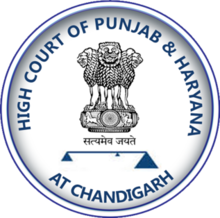| Punjab and Haryana High Court | |
|---|---|
 | |
 Facade of the High Court Building | |
 | |
| Established | 15 August 1947 |
| Jurisdiction | Punjab, Haryana and Chandigarh |
| Location | Chandigarh |
| Composition method | Presidential with confirmation of Supreme Court Collegium including Chief Justice of India on recommendation of High Court Collegium. |
| Authorised by | Constitution of India |
| Appeals to | Supreme Court of India |
| Judge term length | Mandatory retirement at 62 years of age |
| Number of positions | 85 (64 Permanent, 21 Additional) |
| Website | High Court of Punjab and Haryana |
| Chief Justice | |
| Currently | Justice Sheel Nagu |
| Since | 9 July 2024 |
Punjab and Haryana High Court is the common High Court for the Indian states of Punjab and Haryana and the Union Territory of Chandigarh based in Chandigarh, India. Sanctioned strength of Judges of this High Court is 85 consisting of 64 Permanent Judges and 21 Additional Judges including Chief Justice. As of 14 September 2023, there are 58 Judges working in the High Court, comprising 36 Permanent and 22 Additional Judges.[1]
The court building is known as the Palace of Justice. Designed by Le Corbusier, it and several of his other works were inscribed as UNESCO World Heritage Sites in July 2016.[2][3]
Sarv Mittra Sikri, who had been practising in the High Court of Punjab and Haryana and remained Advocate-General for Punjab from 1 November 1956 to 2 February 1964, was the first to be appointed as judge of the Supreme Court of India on 3 February 1964 directly from the Bar; later, becoming the Chief Justice of India on 22 January 1971, again with the distinction of being first of only two CJIs directly from the Bar.
Past judges include Madan Mohan Punchhi, P. Sathasivam, Tirath Singh Thakur, Jagdish Singh Khehar and Ranjan Gogoi who were elevated to the Supreme Court of India and became Chief Justice of India.[4][5][6]
- ^ https://www.highcourtchd.gov.in/index.php?mod=chief [bare URL]
- ^ "The Architectural Work of Le Corbusier". UNESCO World Heritage Centre. United Nations Educational, Scientific and Cultural Organization. Retrieved 19 July 2016.
- ^ "Chandigarh's Capitol Complex is now a UNESCO heritage site". 18 July 2016. Retrieved 18 July 2016.
- ^ Tribune News Service. "HC starts e-filing, gets Wi-Fi complex".
- ^ http://highcourtchd.gov.in/sub_pages/left_menu/publish/announce/announce_pdf/protection_15032013.pdf [bare URL PDF]
- ^ "Hon'ble Chief Justice and Judges of the High Court of Punjab and Haryana".